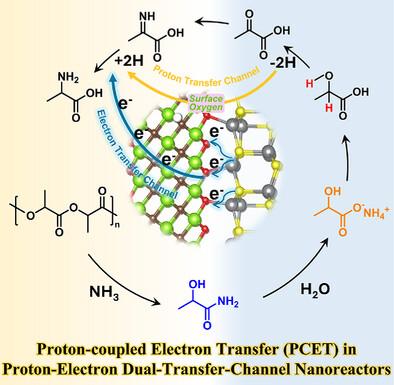质子-电子双转移通道纳米反应器用于光催化聚酯脱氢-还原胺化反应
IF 19
1区 材料科学
Q1 CHEMISTRY, MULTIDISCIPLINARY
引用次数: 0
摘要
光催化聚酯到氨基酸的转化对废物升级回收具有重要意义,但由于需要复杂的多个质子和电子转移过程,因此具有挑战性。本文通过模板外延生长和缺陷介导的界面键构建,建立了一种中空核壳Sv-硫族化物/Ti3C2纳米反应器(Sv =硫空位,chalcogenide = CdS/ZnIn2S4/CdIn2S4)的合成策略,该反应器作为光催化聚合物-氨基酸脱氢-还原胺化反应中串联质子耦合电子转移(PCET)的强质子/电子萃取器和中继站。这些纳米反应器集成了空间分离的质子-电子双转移通道,其中界面不对称电荷分布诱导的内置电场(BIEF)驱动从硫系化合物到Ti3C2的定向电子转移(ET),而富电子的界面晶格氧通过亲核抽象介导底物去质子化过程,将质子传递到Ti3C2并形成Ti3C2(OH) +中间体触发质子转移(PT)。具有代表性的Sv-CdS/Ti3C2空心纳米反应器(HNR)通过对关键中间体吸附和活化能量的精确调控,实现了分子催化行为的动态优化,表现出10 mmol·g−1·h−1和91%的丙氨酸选择性,具有良好的性能和广泛的适用性。本研究为质子-电子双转移通道光催化剂的设计建立了一个开创性的范例,并为复杂反应途径的有效调控提供了新的视角。本文章由计算机程序翻译,如有差异,请以英文原文为准。

Proton-Electron Dual-Transfer-Channel Nanoreactors for Proton-Coupled Electron Transfer (PCET) in Photocatalytic Polyester Dehydrogenation-Reductive Amination
The photocatalytic polyester-to-amino acid transformation is significant for waste upcycling, yet challenging owing to the intricate multiple proton and electron transfer processes required. Herein, a general strategy for synthesizing hollow core-shell Sv-chalcogenide/Ti3C2 nanoreactors (Sv = sulfur vacancies, chalcogenide = CdS/ZnIn2S4/CdIn2S4) is developed via templated epitaxial growth and defect-mediated interfacial bond construction, which act as the strong proton/electron extractor and relay station for tandem proton-coupled electron transfer (PCET) in photocatalytic polyester-to-amino acid dehydrogenation-reductive amination. These nanoreactors integrate spatially segregated proton-electron dual-transfer channels, where the interfacial asymmetrical charge distribution-induced built-in electric field (BIEF) drives directional electron transfer (ET) from chalcogenide to Ti3C2, while the electron-rich interfacial lattice oxygen mediates substrate deprotonation process via nucleophilic abstraction, delivering protons to Ti3C2 and forming Ti3C2(OH)⁺ intermediates to trigger proton transfer (PT). By virtue of dynamically optimized molecular catalytic behavior accomplished through precise regulation of pivotal intermediate adsorption and activation energetics, the representative Sv-CdS/Ti3C2 hollow nanoreactor (HNR) exhibits remarkable performance (10 mmol·g−1·h−1 and 91% selectivity, alanine) and broad applicability for polyester-derived hydroxy acid-to-amino acid transformation. This study establishes a pioneering paradigm for the design of proton-electron dual-transfer-channel photocatalysts and provides novel perspectives for the effective regulation of complex reaction pathways.
求助全文
通过发布文献求助,成功后即可免费获取论文全文。
去求助
来源期刊

Advanced Functional Materials
工程技术-材料科学:综合
CiteScore
29.50
自引率
4.20%
发文量
2086
审稿时长
2.1 months
期刊介绍:
Firmly established as a top-tier materials science journal, Advanced Functional Materials reports breakthrough research in all aspects of materials science, including nanotechnology, chemistry, physics, and biology every week.
Advanced Functional Materials is known for its rapid and fair peer review, quality content, and high impact, making it the first choice of the international materials science community.
 求助内容:
求助内容: 应助结果提醒方式:
应助结果提醒方式:


